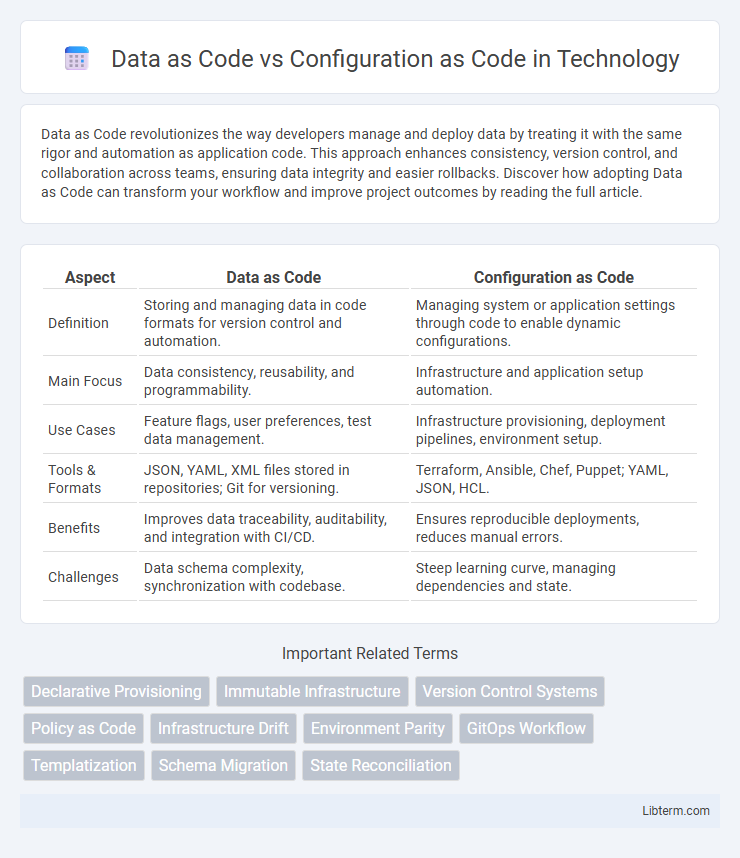Data as Code revolutionizes the way developers manage and deploy data by treating it with the same rigor and automation as application code. This approach enhances consistency, version control, and collaboration across teams, ensuring data integrity and easier rollbacks. Discover how adopting Data as Code can transform your workflow and improve project outcomes by reading the full article.
Table of Comparison
| Aspect | Data as Code | Configuration as Code |
|---|---|---|
| Definition | Storing and managing data in code formats for version control and automation. | Managing system or application settings through code to enable dynamic configurations. |
| Main Focus | Data consistency, reusability, and programmability. | Infrastructure and application setup automation. |
| Use Cases | Feature flags, user preferences, test data management. | Infrastructure provisioning, deployment pipelines, environment setup. |
| Tools & Formats | JSON, YAML, XML files stored in repositories; Git for versioning. | Terraform, Ansible, Chef, Puppet; YAML, JSON, HCL. |
| Benefits | Improves data traceability, auditability, and integration with CI/CD. | Ensures reproducible deployments, reduces manual errors. |
| Challenges | Data schema complexity, synchronization with codebase. | Steep learning curve, managing dependencies and state. |
Introduction to Data as Code and Configuration as Code
Data as Code treats data sets as version-controlled, testable, and deployable elements, enabling consistent, automated management across environments. Configuration as Code involves storing infrastructure and application settings in declarative files, ensuring repeatable and auditable provisioning. Both approaches enhance DevOps practices by integrating data and configurations into development workflows, improving collaboration and reducing errors.
Core Concepts: Defining Data as Code
Data as Code defines data structures and application state through declarative, version-controlled files that treat data similarly to software code, enabling automated testing and validation. It emphasizes immutability and consistency by storing configuration data in code repositories, ensuring traceability and collaboration. This approach contrasts with Configuration as Code, which primarily automates infrastructure setup by defining system configurations using code.
Core Concepts: Defining Configuration as Code
Configuration as Code involves managing infrastructure and application settings through declarative files that can be version-controlled, enabling consistent and repeatable deployments. It emphasizes defining system configurations, environment variables, and service parameters in code formats like YAML or JSON, allowing automation and minimizing manual errors. This approach ensures that configurations are treated as immutable artifacts, facilitating collaboration and traceability across development and operations teams.
Key Differences Between Data as Code and Configuration as Code
Data as Code emphasizes managing application data through version-controlled code, enabling data transformations, validations, and governance within development workflows. Configuration as Code focuses on defining infrastructure and application settings in declarative files, ensuring consistent environment provisioning and deployment automation. Key differences lie in their primary targets: Data as Code addresses dynamic data management, while Configuration as Code governs immutable environment and application configurations.
Use Cases for Data as Code
Data as Code enables real-time data processing and analytics by treating datasets as version-controlled, testable artifacts, ideal for machine learning model training and feature engineering. It supports continuous integration and deployment pipelines where data transformations and validation rules are codified for reproducibility and auditability. Use cases include automated data quality checks, dynamic feature store updates, and infrastructure-as-data scenarios in data-intensive applications.
Use Cases for Configuration as Code
Configuration as Code enables scalable infrastructure management by defining system settings in version-controlled files, ideal for automated environment setups and consistent deployments. It facilitates rapid recovery and scaling of cloud resources, supports compliance auditing through traceable changes, and integrates seamlessly with CI/CD pipelines for continuous delivery. Use cases include managing Kubernetes cluster configurations, provisioning virtual machines with Terraform, and setting up application environments using Ansible playbooks.
Benefits of Data as Code
Data as Code enhances agility by enabling version control and automated testing for datasets, ensuring consistency and reliability across deployments. It simplifies collaboration among data engineers and developers by treating data with the same rigor as application code, reducing errors and improving traceability. This approach accelerates iterative development cycles and fosters seamless integration with CI/CD pipelines, boosting overall operational efficiency.
Advantages of Configuration as Code
Configuration as Code centralizes infrastructure settings in version-controlled files, enabling consistent, repeatable deployments across environments. It improves collaboration among development and operations teams by providing clear, auditable change history, reducing configuration drift and misconfigurations. Automation tools leverage Configuration as Code to streamline provisioning and scaling, enhancing operational efficiency and reliability.
Challenges and Considerations for Both Approaches
Data as Code and Configuration as Code both present unique challenges in versioning, validation, and maintainability due to their differing complexities and usage contexts. Data as Code requires careful handling of data integrity and schema evolution to prevent corruption and ensure consistency, while Configuration as Code demands strict adherence to environment-specific parameters and dependency management to avoid deployment failures. Both approaches necessitate robust testing frameworks and collaboration practices to minimize errors and streamline updates in continuous integration and delivery pipelines.
Choosing the Right Approach: Data as Code vs Configuration as Code
Choosing the right approach between Data as Code and Configuration as Code depends on factors such as system complexity, scalability requirements, and deployment frequency. Data as Code emphasizes managing dynamic, mutable datasets through version-controlled code, ideal for applications needing frequent data updates, while Configuration as Code focuses on managing static environment settings and infrastructure configurations to ensure consistent deployments. Evaluating the nature of changes and the need for automation helps determine whether a data-centric or configuration-centric codebase will optimize maintainability and operational efficiency.
Data as Code Infographic

 libterm.com
libterm.com